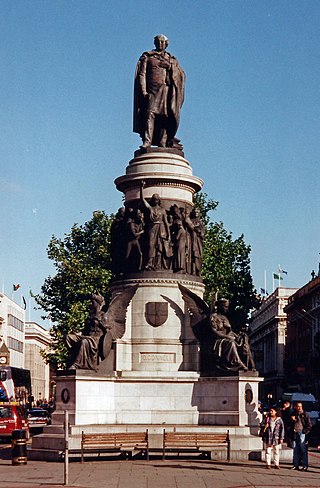
O'Connell Street is a street in the centre of Dublin, Ireland, running north from the River Liffey. It connects the O'Connell Bridge to the south with Parnell Street to the north and is roughly split into two sections bisected by Henry Street. The Luas tram system runs along the street.

The Spire of Dublin, alternatively titled the Monument of Light, is a large, stainless steel, pin-like monument 120 metres (390 ft) in height, located on the site of the former Nelson's Pillar on O'Connell Street, the main thoroughfare of Dublin, Ireland.

The General Post Office is the former headquarters of An Post — the Irish Post Office. It remains its registered office and the principal post office of Dublin — the capital city of Ireland — and is situated in the centre of O'Connell Street, the city's main thoroughfare. It is one of Ireland's most famous buildings, not least because it served as the headquarters of the leaders of the Easter Rising against British rule in Ireland. It was the last great Georgian public building to be erected in the capital.
The Capitol Theatre was located in Prince's Street, just off O'Connell Street, Dublin, and began life on 10 August 1920 as the La Scala Theatre and Opera House. Designed by architect T. F. McNamara it had two balconies in the 1,900-seat auditorium with 32 private boxes. Despite its name, the La Scala was a cinema. Paramount Pictures took over the lease on the building and renamed it the Capitol in 1927. Under new management, the Capitol ran a live show every week to accompany the current film.

Molesworth Street is a street in Dublin, Ireland named after Richard Molesworth, 3rd Viscount Molesworth and links the more notable Dawson Street with Kildare Street and lies just over 200 m to the north of St. Stephens Green in Dublin's central business district.

O'Connell Street is the main thoroughfare of the city of Limerick. It was previously known as George's Street until it was renamed after Daniel O'Connell. The street runs in parallel to the River Shannon and forms part of an overall thoroughfare, along with Rutland Street and Patrick Street, that bisects Limerick City Centre in a north east to south west direction. The street is about a mile in length, starting at the Arthurs Quay / Denmark Street junction and ending at The Crescent. A monument to Daniel O'Connell stands at the centre of The Crescent overlooking O'Connell Street. The street is noted for its Georgian architectural heritage.

The Screen Cinema was a three-screen cinema in Hawkins Street, Dublin, Ireland.

The Savoy Cinema is the oldest operational cinema in Dublin, and it is the preferred cinema in Ireland for film premières.

St. Mary's Abbey was a former Cistercian abbey located near the junction of Abbey Street and Capel Street in Dublin, Ireland. Its territory stretched from the district known as Oxmanstown down along the River Liffey until it met the sea. It also owned large estates in other parts of Ireland. It was one of several liberties that existed in Dublin since the arrival of the Anglo-Normans in the 12th century, which gave it jurisdiction over its lands.

D'Olier Street is a street in the southern city-centre of Dublin, the capital of Ireland. It and Westmoreland Street are two broad streets whose northern ends meet at the southern end of O'Connell Bridge over the River Liffey. Its southern end meets Fleet Street, Townsend Street, College Street and Pearse Street.

Cineworld Dublin is a cinema in Dublin notable for being the biggest cinema in Ireland, with 4 floors and 17 screens. It is located on Parnell Street, Dublin and is owned by the Cineworld cinema chain.
Tholsel was a name traditionally used for a local municipal and administrative building used to collect tolls and taxes and to administer trade and other documents in Irish towns and cities. It was at one stage one of the most important secular buildings in Ireland's town and cities and the level of importance was reflected in the prominence and size of these buildings as well as the expensive materials and architectural techniques used. Some historic tholsels still exist, notably The Tholsel, Kilkenny. Towards the end of the 18th century the term tholsel was typically swapped for Market House with many of the administrative functions of the original tholsel transferring to another dedicated local council or government building such as a court or sessions house.

The Hotel Metropole was a notable landmark hotel in Dublin, Ireland. It was located next to the General Post Office building in O'Connell Street. Originally four Georgian buildings, they were combined to form a unified hotel in a high-french style by architect William M. Mitchell in 1891–93. Various architectural additions and embellishments were included to make the building look more French including a mansard roof with rounded dormer windows. This followed the style other Dublin hotels were adopting at the time including the Shelbourne Hotel and nearby the Jury's Hotel at College Green.
The Theatre De Luxe was a film theatre on Camden Street in Dublin, Ireland from 1912 to 1975.

North Earl Street is a short stretch of city-centre street located on Dublin's Northside and formerly a major shopping area. It runs from Marlborough Street in the west to O'Connell Street beside the Spire.

O'Connell Bridge House is a 12-storey office block in Dublin, Republic of Ireland.

Hawkins Street is a street in central Dublin, Ireland. It runs south from Rosie Hackett Bridge, at its junction with Burgh Quay, for 160 metres (170 yd) to a crossroads with Townsend Street, where it continues as College Street.

Hawkins House was a 12-storey office block in Dublin, Ireland. It was demolished in 2021.

Apollo House was a 9-storey office block in Tara Street, Dublin, Republic of Ireland.

Piccadilly Cinema(s), formerly Piccadilly Theatre and Forum Cinema, and also known as The Piccadilly, is a cinema located on the corner of O'Connell Street and Childers Street in North Adelaide, South Australia.




















